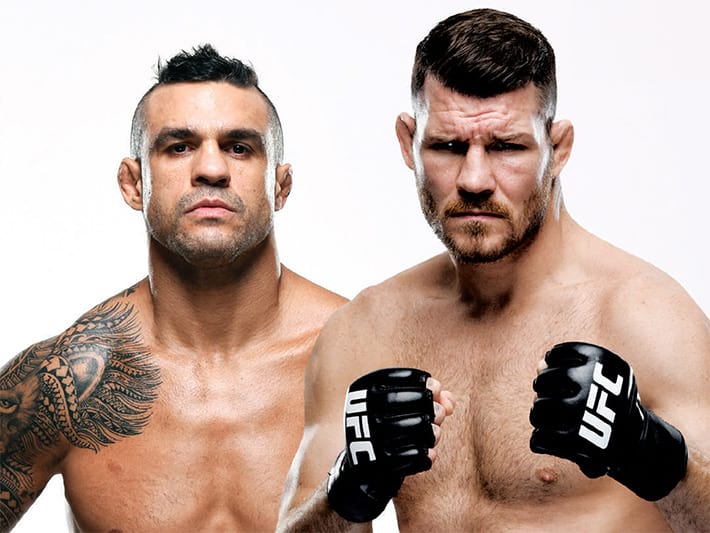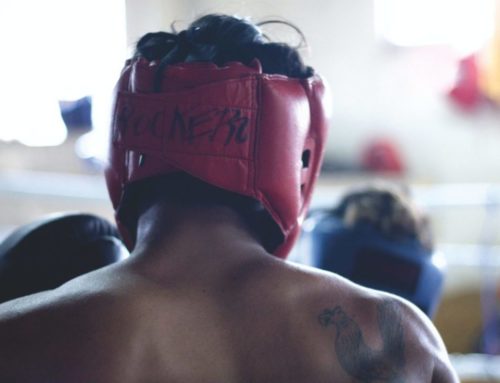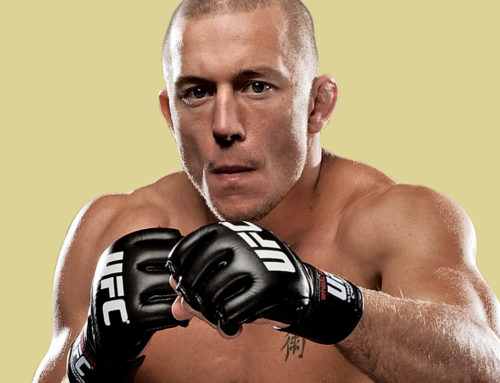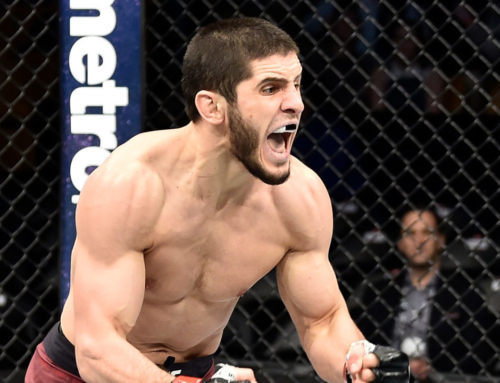Michael Bisping and Vitor Belfort have both called time on their storied careers. FIGHTERS ONLY looks back at their remarkable achievements in the sport and how the two warriors’ intertwined careers have created a legacy few will equal.
May, 2018, will be remembered in Mixed Martial Arts for the retirement of two juggernauts of the sport from Britain and Brazil: Michael Bisping and Vitor Belfort. Both servants, both entertainers, both, ultimately, champions in word and in deed. Belfort fought for a final time, perhaps fittingly, against a fellow Brazilian legend in Lyoto Machida at UFC 224 in the first fight on the main card in Rio de Janeiro. He was knocked out after a minute of the second round by front kick. The final blow as the curtain came down on a two-decade career.
Michael Bisping, a mere three weeks after losing the middleweight crown by submission at Madison Square Garden, New York, to a returning Georges St Pierre was also stopped by Kelvin Gastelum in the inaugural UFC event in mainland China, having come to the rescue of the company that has defined him as a fighter and as a television personality.
Shanghai marked the end of Bisping’s fighting career.
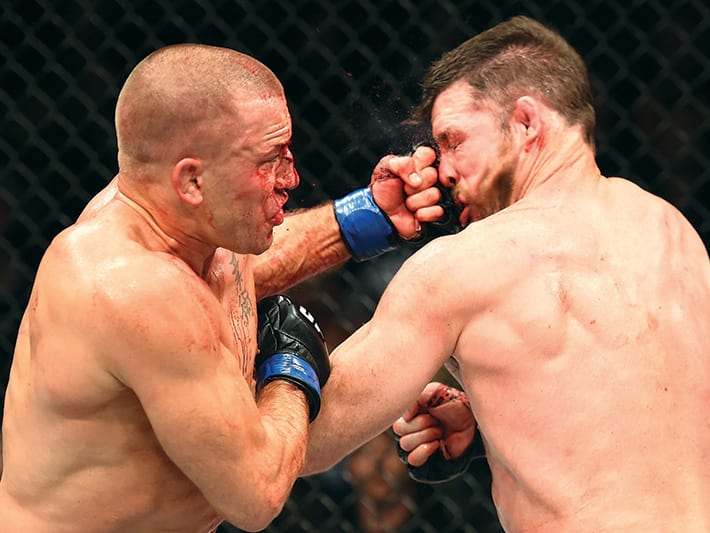
GSP lands a left on Bisping on his blood-soaked way to regaining the middleweight crown at UFC 217 last year.
Timing is everything in sport, and time in mixed martial arts, as we learn increasingly, waits for no man. But the meandering rivers of both men’s careers criss-crossed for almost twelve years in the same organisations. They met of course, in January 2013, on a night when Bisping’s destiny was changed and when Belfort’s victory was later shrouded in controversy with his use of the now-outlawed Testosterone Replacement Therapy (TRT). Significantly, a vicious second-round kick delivered by Belfort detached Bisping’s retina and left him permanently disfigured.
That night in Sao Paolo, the main event on an FX card, is the sole meeting on the Bisping-Belfort timeline. Bizarrely, it was the result of another drug ban that saw Belfort’s resumé take him to other corners of the world, his career criss-crossing into Cage Rage in the UK whose light heavyweight title he held in 2007. Follow the timeline, again, and that was the same title Bisping had held in 2004.
If those are some of the negatives bestowed on Belfort – of his own doing – there are so many positives, too. The sport has been cleaned up, changed beyond all recognition from the moment that he became a notable addition to it two decades ago. Belfort strode into the fight game, bristling with intent. One suspects that in time, Belfort is destined for a place in the UFC’s Hall of Fame, as no doubt Bisping will be, too. Go back to the start, and Brazil’s ‘Phenom’ smashed and grabbed the UFC 12 Heavyweight tournament as a raw, frighteningly powerful 19 year old, full of explosive destruction, in a world unrecognisable by today’s standards.
At his most imposing, a very left handed 6ft tall fighter at his heaviest weighing 220lbs, Belfort was a southpaw wrecking machine. Little wonder that of his 26 wins, 18 came by knockout, but as time caught up with him, his naturally reflexive and explosive power left him, and his chin became suspect. But consider the length and expanse of his career and it is as impressive as anyone’s in the sport, and indeed, the changes in MMA over the two decades in which he competed need contextualising.
It was literally open weight when he started. By today’s standards, and skill sets, he is no heavyweight.
To look back at Belfort’s career is to marvel at both its longevity and the calibre of his opponents, a Who’s Who of the sport’s greatest fighters. It speaks to so many battles, so many styles. The trilogies with Dan Henderson and Randy Couture, a pair of fights with Alistair Overeem, Tito Ortiz, Chuck Liddell, Rich Franklin, Wanderlei Silva, and in the more modern times the addition of Jon Jones, that great event in Las Vegas against Anderson Silva, Chris Weidman, et al to a new generation. Always the very best competition. He did not beat them all, of course, but we were always intrigued, Belfort was always ‘a name’. It barely matters that he only won two of his last seven fights. The greats find it so hard to hang ‘em up, and so it was with Belfort. Aged 41, it was clearly time for closure.
Worth recalling here his early journey, and the foundations that built him. He came from the Brazilian middle class. He was raised by his mother, but when the family lost everything, he felt he had to move to America, he told me in an interview, “to go in search of my dreams”.
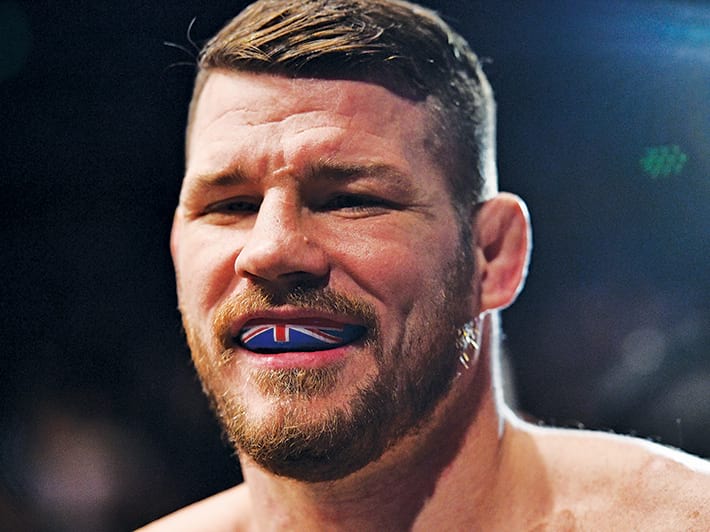
Michael Bisping: “I beat Anderson. I got the gold. They say to become a legend, you have to beat a legend. I think my place in the history books is safe.”
“It doesn’t matter how much money or success you have in life, when the rough times arrive you have to keep faith,” he explained to Fighters Only Magazine. “It’s all about having faith and believing in what you do. I learned that in life you have to fight through the hard times and maintain your integrity.”
It was tough back then in the streets in Brazil before he had chased The American Dream, and MMA’s Holy Grail. It still is. There were lessons. “If you want to be tough in life, it’s not about how hard you hit, it’s about how hard you can get hit and keep standing and come back,” he recalls. Physically, Vitor learnt to spar hard, often with no gum shield, returning home beaten up and often with black eyes. At a young age, he would tell his mother, Maria, that it was from playing football. He was 13 years old then, learning under Claudio Coelho at the Nobre Arte Academy, located in Rio de Janeiro’s Cantagalo community.
“We used to do a lot of sparring. We were learning to have fist fights but with big gloves. I always loved boxing. I remember they had a professional boxer who used to be
there with us and he’d say, ‘Man, you have talent. You should learn how to box’. He used to come and train me under the building. I used to go to this boxing gym and that’s how I learned about MMA. For me, if I wanted to do MMA, I had to learn how to punch.”
But that was not enough for success in MMA – just “being able to punch”. Not that he fully realised it at the time. But by coming under the wing of Carlson Gracie and his jiu jitsu academy, Belfort became one of the world’s biggest draws, through his three periods in the UFC, through PRIDE, Strikeforce, Affliction, and Cage Rage.
“I was 13 years old when I met Carlson and I used to train in my neighbourhood with one of his students. I remember saying I didn’t want to do jiu-jitsu because I didn’t see a future in it. There was no money, no career. I wanted to do something that helped me make money. I never knew that one day MMA was going to be big. What I did was I went to Carlson because he was the best guy in the business. He knew so much about fighting. He was the main guy. I went to visit him at 13 and he took a look at me and said, man, you’re going to be something else – you should come here. I used to go all the time and we built a relationship.”
Later, of course, Belfort went to Los Angeles, with Carlson, and they began to build. “Our dreams started to come true. Of course, we had some rough times, but, looking back, it was an adventure for me. I was confident our time would come and I would make it.” And so he did. And the rest is a long, and tapestried history.
So, to Bisping, who retired aged 39 and was the original ‘Great British Hope’ way back in 2007. He was the poster boy – literally the only real poster boy for British MMA. He was the winner of ‘The Ultimate Fighter’ season 3, the first British MMA athlete to win TUF. There were milestones along the way. He became the first British fighter to headline a UFC card at UFC 78. I was there in Newark, New Jersey. Bisping had a very close three-round fight with Rashad Evans, at light heavyweight. He fought on UFC 100, banjoed by Dan Henderson, but later avenged defeat when he defended the belt against the cock-hammer right handed KO merchant in Manchester. But there were so many highlights, so many great nights: three title eliminators, returns to the UK to headline, being a coach on TUF, bringing MMA to prominence in the UK.
In 2016, nine years after his UFC debut, after playing the heel, being loved and loathed but consistently picking up fans, and always being a feature wherever he held court, ‘The Count’ had forged a reputation as a man who sold fights, sometimes lost them, but never, ever returned a broken fighter. If the UFC wanted him, Bisping was available, ready, a mouthpiece, a challenger, the leading man from Britland, happy to let himself go on any foe. He won, he lost, he won, but crucially, he never, ever gave in.
In the third week of May 2016, working on feature film in Canada, Bisping was given 16 days notice by Dana White, the UFC President, that he had a rematch with Luke Rockhold, then the UFC middleweight champion, if he wanted it. He took it in a heartbeat, and it was an emotional moment for him when he recalled it to me later. He ran for several miles that day, shed a tear, and then got himself back into camp quickly with a ‘no fear, nothing to lose’ mindset. He felt like he was being fed to Rockhold, but knew it was time to take what he knew could be his. Carpe Diem.
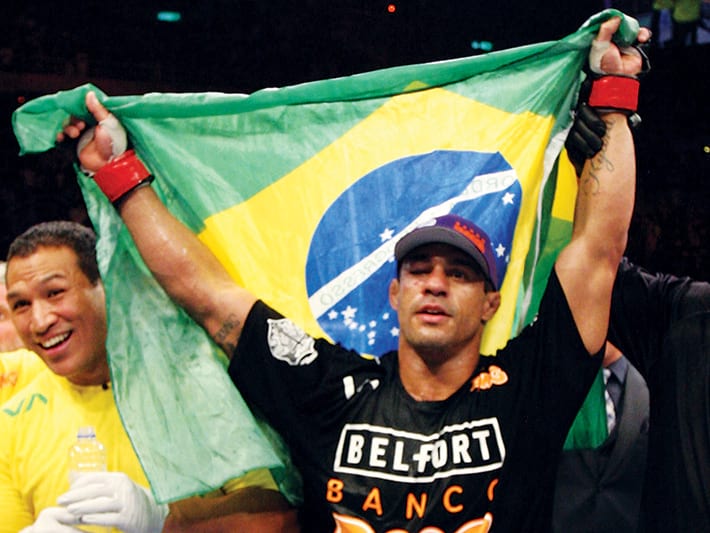
Fly the flag: Belfort’s alliance with fellow Brazilian, Carlson Gracie made him one of the sport’s biggest draws.
The lack of anxiety let Bisping go into the fight with utter self belief and a studied gameplay from striking coach Jason Parillo, and in a defining moment, he became the first British fighter to claim a UFC title. It was thrilling, short, and very, very popular. It was Bisping’s left hook which showed his finishing power. The title triumph cemented the British standout as one of the best of the era, a generation of fighters now being usurped by the likes of Conor McGregor and Darren Till. That was in June 2016.
In February that year, in a column in Fighters Only Magazine, I wrote what was almost a retrospective on his career then, how he had “truly become an ambassador for mixed martial arts, the UFC and British sport”. With the belt, Bisping became the greatest MMA export to come out of this country and he has since grown to a new level.
From understanding the nature of promoting fights, to being an analyst, from having gone from hero, to heel, to villain, to MMA personality, he has forged a television and film career, and is widely recognised in the United States. The sense is that he has an even wider profile and platform in the USA, where the sport is at its strongest, than in the UK.
Four months later, in June 2016, with the belt in his grasp, we sat down for an interview. He had beaten Anderson Silva by then, too, in a bizarre and controversial fight in London. At UK events, by the way, Bisping is as adored by fans watching live as I have ever witnessed any fighter – in any combat sport – on home soil.
“I’m still getting used to being called a UFC champion,” he had said. “It’s kind of weird. It’s been a lifetime’s work. It sounds fantastic. It still feels strange but it certainly feels good.” He had a lightness of being, a weight had lifted. History and debates could no longer be ambivalent about what Bisping had achieved in MMA and the UFC. Ten long, hard years. And nagging retirement thoughts, he revealed, had entered his head going into that fight with Rockhold at the Inglewood Forum.
“That was something that was in the back of mind. I was in two minds. My wife wanted me to retire whether I won or lost. I toyed with the idea of retiring but I don’t want to retire on a loss. I want to retire on a win. I’ve achieved the ultimate in the sport I have dedicated my life to. This for me is like getting a gold at the Olympics. It doesn’t get any bigger.” Try, try, and try again. Never really beaten. Only by time. And the ravages of a career hard-fought.
On the day Bisping defeated Rockhold. Muhammad Ali had passed away. Ali had always been a hero for ‘The Count’, and he had fought in the same arena as his hero. It was global news. Under the radar, and almost drowned out by Ali obituaries, Bisping lifted the crown later that night.
“I sat with my team in our hotel room on the day of the fight and we were all in shock. Not disbelief but shock and sadness,” he recalled. “The world had lost one of its true icons and legends. He was a man who captured the world’s imagination, one of the most charismatic people to walk the earth. I would never, ever put myself in the same sentence as Muhammad Ali but it was kind of weird to think that he died and then I was fighting for the title in an arena where Ali had fought. It put a smile on my face. It was a nice way of paying my own personal tribute to Ali.”
Legacy comes in here, and Bisping’s victory set up a much-needed belief system for mixed martial arts in the UK. In some respects, you could argue that he had become a figurehead without an anchor. The title win finally rubber-stamped him as the most accomplished British MMA fighter of all time. Bar none.
“We’ve always wanted a UK champion and we finally have one now,” he’d said. “I honestly believe I’ve had a positive impact on the sport. I think this will inspire some kids and other fighters to fulfil their dreams and their potential.” There’s no question about that.
“People have always been kind and said I was the poster boy for MMA in the UK but I was never overly-comfortable with that because I was always embarrassed that as the UK’s flagship fighter I wasn’t able to win a title. That was always a problem I had with that moniker. Here I am, supposed to be the UK number one, yet I can’t go out and win a title. The UK always deserved that champion.”
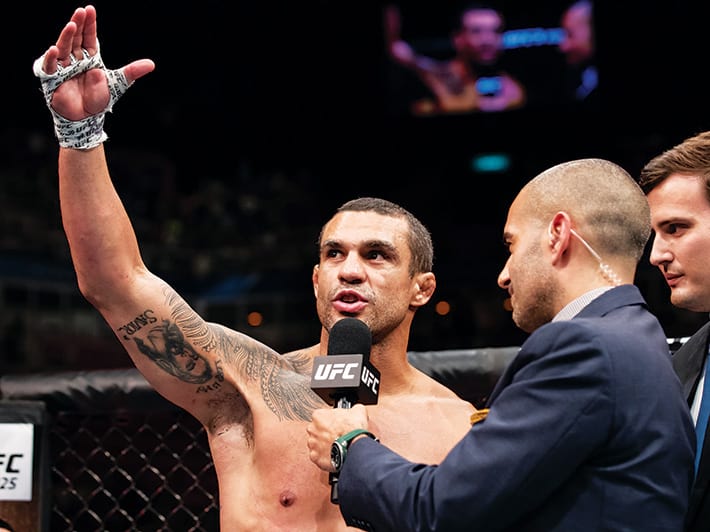
“I learned that in life you have to fight through the hard times and maintain your integrity”
He threw off a stigma for himself too, and powerfully moreover, that he was a good fighter who always lost the big ones. And those were his words. “I know I’ve lost at crucial moments. I know I’ve been in number one contender match-ups three times and I’ve lost those match-ups.” In a sideways reference to the Belfort loss, he added, “You can talk about TRT and whatever but that’s by the by. The fact is I lost those fights. But I think the fact I was able to make it to number one contender status not once, not twice but three times is testament to my fighting spirit, my will, my determination.”
The victory over Silva, worth noting, was also huge. And it was to Bisping. Perhaps more than winning the belt. Silva has been regarded by many as the GOAT, it was a homecoming fight for Bisping, against a legend himself who “captures the imagination of the mixed martial arts world”
“I beat Anderson, I got the gold. They say to become a legend you have to beat a legend. I think my place in the history books is safe and my legacy is cemented.” As well as that, there is his legacy in the UK, no-one has done more than Bisping to promote MMA in the UK.
“The growth has always been constant but there’s still a lot more that needs to happen. Guys like Conor McGregor are helping break down barriers as well,” he says.
Bisping, the ‘poster boy’ of British MMA, has never been anything other than himself. He will be missed. “I never once considered myself the poster boy of British MMA. All I was trying to do was be me. I just wanted to look after my family as best as I possibly could.”
Two fighters, two fascinating careers for very different reasons. As Belfort once told me: “If you don’t evolve in this sport, you end up left behind. Fighters who are left behind have to retire.” The Brazilian’s evolution was complete. No more evolving to do. The end. And Bisping ? He’s now called an ambassador for the sport.
“Ambassador is a very polite way of saying I’m getting old,” laughs Bisping. The right time, then, career-wise to ride off into the setting sun…

